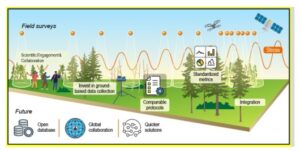A global survey of forest monitoring plots points the way forward for improved monitoring of tree mortality and support of robust collaborations.

A global tree mortality monitoring system is crucial for climate mitigation. Data integration and representative collaboration can improve assessments and policy decisions. (Figure from Esquivel-Muelbert, et al. 2025)
The Science
Environmental change is driving greater mortality of trees worldwide, but no comprehensive assessment of global tree mortality exists. To address this gap, a large international and multidisciplinary team integrated data from long-term forest monitoring plots around the world, leveraging satellite data for a truly global picture based on almost a half-million plots across 89 countries and five continents. The authors are from 132 different institutions around the world and propose integrating ground-based data with satellite technology to create a global monitoring system to better understand tree death and develop strategies to protect forests and combat climate change. They emphasize that a truly global monitoring effort should promote geographically broad collaborations that support temporally and methodological consistency and alleviate issues of limited spatial and temporal gaps in forest monitoring records.
The Impact
This research addresses the growing problem of tree mortality worldwide, which affects forests and human societies. This is the first effort to integrate forest inventory networks from around the world, including scientists and citizens by combining ground surveys with satellite images to track tree deaths more accurately. This information helps elucidate the long-term impacts of tree mortality on forest ecosystems, their biodiversity, and the ecosystem services they provide. Such a network also helps scientists predict future tree mortality and its impact on Earth system processes to support better-informed management of global forests.
Summary
This research highlights the urgent need for a comprehensive global system to monitor tree mortality, as increasing rates of tree death have significant implications for forest ecosystems and their services. Rates of tree mortality are rising but there is a lack of consistent global data to monitor and understand these trends. By synthesizing data from 466,865 forest monitoring plots across 89 countries, a large and international team of authors argue that there are significant gaps in ground-based monitoring, particularly in regions like Russia, West Africa, and Central America. They propose integrating ground-based forest inventories with remote sensing and modeling to fill these gaps. This integration requires developing technical solutions for data comparability, enhancing data collection in understudied areas and fostering robust collaborations by engaging local scientists. More data with standardized metrics for tree mortality and regular ground surveys complemented by use of new technologies will support robust predictions of tree mortality.
DOE PM Contacts
- Daniel Stover, Environmental System Science Program, daniel.stover@science.doe.gov
Research Contacts
- Vanessa L. Bailey, vanessa.bailey@pnnl.gov, Pacific Northwest National Laboratory, COMPASS-FME Principal Investigator
- Nate McDowell, nate.mcdowell@pnnl.gov, Pacific Northwest National Laboratory
- Ben Bond-Lamberty, BondLamberty@pnnl.gov, Pacific Northwest National Laboratory
Funding
A portion of this research was supported by COMPASS-FME, a multi-institutional project supported by the Department of Energy, Office of Science, Biological and Environmental Research as part of the Environmental System Science Program. This synthesis was an international effort supported by a number of different agencies around the world.
Publication
International Tree Mortality Network, Cornelius Senf, Adriane Esquivel‐Muelbert, Thomas AM Pugh, William RL Anderegg, Kristina J. Anderson‐Teixeira, Gabriel Arellano et al. “Towards a global understanding of tree mortality.” New Phytologist (2025). https://doi.org/10.1111/nph.20407
Related Links
International Tree Mortality Network Webpage